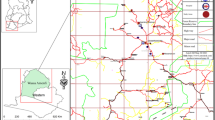Abstract
Small-scale forestry-based enterprises connected with wood processing are becoming of growing importance in the rural economy of developing countries. Little attention has been paid to the characteristics of these enterprises and their role in supporting economic development. The objectives of this study are to: (1) determine the socioeconomic characteristics of the operators of these enterprises; (2) assess the contribution of the informal carpentry sector to operators’ income; and (3) identify the factors limiting the expansion of the sector. The study was carried out in the Singa district, Sinnar State in 2011. Snowball sampling was used to select 250 operators from five markets in the district. The quantitative and qualitative data were collected using Participatory Rural Appraisal methods. The results revealed that most operators involved in the informal carpentry sector are males aged <30 years and their businesses have been in existence for <10 years. Operators’ incomes ranged between USD 100 and 500 monthly on average. The results also indicated that the operators face many constraints (e.g. finance shortage, lack of raw materials, insecure market, lack of technology and lack of organization) to expanding the informal carpentry sector. The study concluded that the informal carpentry sector has potential to contribute to rural economic development through increasing income and reducing rural poverty.


Similar content being viewed by others
References
Arnold JEM (2001) Forestry, poverty and aid. Center for International Forestry Research (CIFOR), Bogor, Indonesia. Occasional Paper No. 33:14–16
Billetoft J (1989) Rural non-farm enterprises in western Kenya, spatial structure and development. Paper No 89.3. Center for Development Research, Copenhagen, Denmark, pp 12–14
Binh Bui H, Harrison S, Lamb D, Brown SM (2005) An evaluation of the small-scale sawmilling and timber processing industry in northern Vietnam and the need for planting particular indigenous species. Small-Scale For 4(1):85–100. doi:10.1007/s11842-005-0006-9
Breman J (1996) Footloose labour: working in India’s informal economy. Cambridge University Press, Cambridge, pp 200–201. ISBN 9780921568241
Dubey P (2008) Investment in small-scale forestry enterprises: a strategic perspective for India. Small-Scale For 7(2):117–138. doi:10.1007/s11842-008-9045-3
FAO (1987) Small-scale forest-based processing enterprises. Forestry Paper 79. Food and Agriculture of the United Nations, Rome. ISBN: 92-5-1025-703, pp 35–52
FAO (2005) Community-based commercial enterprises development for the conservation of biodiversity in Bwindi World Heritage Site, Uganda. Food and Agricultural Organization (FAO) of the United Nations, Forestry Policy and Institutions Service (FONP), Forestry Department. Rome, Italy, pp 9–29. http://www.fao.org/forestry/9660-06cc0f0249e95b986b8ae8a8686aa8a9b.pdf. Accessed Aug 2012
FAO (2006) Community-based commercial enterprises development for the conservation of biodiversity in Mount Emei World Heritage Site, Sichuan, China. Food and Agricultural Organization (FAO) of the United Nations, Rome, Italy. Forestry Policy and Institutions Working Paper 17:10–19. foris.fao.org/static/data/enterprises/China-casestudy.pdf. Accessed August, 2012
Fisseha Y (1987) Basic features of rural small-scale forest-based processing enterprises in developing countries. FAO Forestry Paper (79), Food and Agricultural Organization (FAO) of the United Nations, Rome, Italy. www.fao.org/docrep/s8380e/s8380e05.htm. Accessed August, 2012
Forest National Corporation (2011) Annual statistics report in Sinnar State, Singa District
Haggblade S, Hazell P, Reardon T (2002) Strategies for stimulating poverty-alleviating growth in the rural non-farm economy in developing countries. International Food Policy Research Institute and Rural Development Department, The World Bank, Washington. http://www.ifpri.org/sites/default/files/publications/eptdp92.pdf. Access Aug 2012
Kozak R (2007) Small and medium forest enterprises: instruments of change in developing world. University of British Columbia, Vancouver, British Columbia, Canada, pp 21–23. http://www.rightsandresources.org/documents/files/doc_3132.pdf. Accessed Aug 2012
Lanjouw P, Feder G (2001) Rural non-farm activities and rural development: from experience towards strategy. Development Economics Research Group, World Bank, Washington, USA, pp 30–34
Lecup I (2011) Community-based tree and forest product enterprises: market analysis and development. Manual. Food and Agricultural Organization (FAO) of the United Nations, Rome, Italy. http://www.fao.org/docrep/014/i2394e/i2394e00.pdf. Accessed Aug 2012
Muwonge A, Obwona M, Nambwaayo V (2007) Enhancing contribution of the informal sector to national development: the case of Uganda. Economic Policy Research Centre (EPRC), 51 Pool Road Makerere University, Kampala, Uganda. p 8
Reinikka R, Svensson J (1999) Confronting competition investment response and constraints in Uganda. Working Paper no. 2242. Washington DC. World Bank, pp 30–35. doi:10.1596/1813-9450-2242. http://elibrary.worldbank.org/deliver/2242.pdf;jsessionid=akpqu14t9yab.z-wb-live-01?itemId=/content/workingpaper/10.1596/1813-9450-2242&mimeType=pdf. Accessed Aug 2012
Schneider F, Enste D (2000) Shadow economies: the Canadian statistical perspectives. Canadian Economic observer, Cat. No 11-010(3):16–33
Sunderlin WA, Angelsen B, Belcher B, Burgers P, Nasi R, Santoso L, Wunder S (2005) Livelihoods, forests, and conservation in developing countries: an overview. World Dev 33(9):1383–1402. doi:10.1016/j.worlddev.2004.10.004
World Bank (2002) Sustaining forests. A World Bank Strategy. World Bank Report of the World Summit on Sustainable Development. World Bank. Washington, DC, USA, pp 2–5
Yin R (1994) Case study research: design and methods. Sage, Beverly Hills, pp 1–38
Author information
Authors and Affiliations
Corresponding author
Rights and permissions
About this article
Cite this article
Adam, Y.O., Pettenella, D. The Contribution of Small-Scale Forestry-Based Enterprises to the Rural Economy in the Developing World: The Case of the Informal Carpentry Sector, Sudan. Small-scale Forestry 12, 461–474 (2013). https://doi.org/10.1007/s11842-012-9223-1
Accepted:
Published:
Issue Date:
DOI: https://doi.org/10.1007/s11842-012-9223-1




